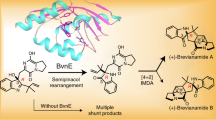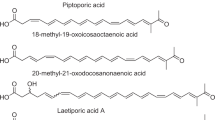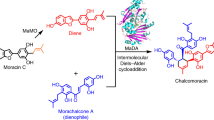Abstract
Epicolactone is a recently isolated fungal metabolite that is highly complex for its size, and yet racemic. With its array of quaternary stereocentres, high degree of functionalization and intricate polycyclic structure, it poses a considerable challenge to synthesis, a challenge that can be met by understanding its biosynthetic origin. If drawn in a certain way, epicolactone reveals a pattern that resembles purpurogallin, the archetype of ubiquitous natural colourants formed via oxidative dimerization. Based on this insight, we designed a biomimetic synthesis of epicolactone that proceeds in only eight steps from vanillyl alcohol. We have isolated a key intermediate that supports our biosynthetic hypothesis and anticipate that an isomer of epicolactone stemming from our synthetic efforts could also be found as a natural product.
This is a preview of subscription content, access via your institution
Access options
Subscribe to this journal
Receive 12 print issues and online access
$259.00 per year
only $21.58 per issue
Buy this article
- Purchase on Springer Link
- Instant access to full article PDF
Prices may be subject to local taxes which are calculated during checkout





Similar content being viewed by others
Change history
21 September 2015
In the version of this Article originally published online there was an error in Figure 3. The citation for the five-step synthesis of epicoccine should have read 'ref. 20'. This mistake was introduced in house and has been corrected in all versions of the Article.
References
Nicolaou, K. C., Vourloumis, D., Winssinger, N. & Baran, P. S. The art and science of total synthesis at the dawn of the twenty-first century. Angew. Chem. Int. Ed. 39, 44–122 (2000).
Nicolaou, K. C. & Sorensen, E. J. Classics in Total Synthesis (VCH, 1996).
Nicolaou, K. C. & Snyder, S. A. Classics in Total Synthesis II (Wiley-VCH, 2003).
Corey, E. J. Retrosynthetic thinking—essentials and examples. Chem. Soc. Rev. 17, 111–133 (1988).
Corey, E. J. & Cheng, X. M. The Logic of Chemical Synthesis (Wiley, 1995).
Corey, E. J. Nobel Lecture. The logic of chemical synthesis: multistep synthesis of complex carbogenic molecules. (1990); www.nobelprize.org/nobel_prizes/chemistry/laureates/1990/coreylecture.html
Wilson, R. M. & Danishefsky, S. J. Pattern recognition in retrosynthetic analysis: snapshots in total synthesis. J. Org. Chem. 72, 4293–4305 (2007).
Bishop, C. M. Pattern Recognition and Machine Learning (Springer, 2006).
da Silva Araújo, F. D. et al. Epicolactone—natural product isolated from the sugarcane endophytic fungus Epicoccum nigrum. Eur. J. Org. Chem. 2012, 5225–5230 (2012).
Talontsi, F. M., Dittrich, B., Schüffler, A., Sun, H. & Laatsch, H. Epicoccolides: antimicrobial and antifungal polyketides from an endophytic fungus Epicoccum sp. associated with Theobroma cacao. Eur. J. Org. Chem. 2013, 3174–3180 (2013).
Brückl, T., Baxter, R. D., Ishihara, Y. & Baran, P. S. Innate and guided C–H functionalization logic. Acc. Chem. Res. 45, 826–839 (2012).
Barltrop, J. A. & Nicholson, J. S. The oxidation products of phenols. Part I. The structure of purpurogallin. J. Chem. Soc. 1948, 116–120 (1948).
Matsuo, Y., Tanaka, T. & Kouno, I. A new mechanism for oxidation of epigallocatechin and production of benzotropolone pigments. Tetrahedron 62, 4774–4783 (2006).
Bentley, R. A fresh look at natural tropolonoids. Nat. Prod. Rep. 25, 118–138 (2008).
Armstrong, S. M. & Patel, T. R. Microbial degradation of phloroglucinol and other polyphenolic compounds. J. Basic Microbiol. 34, 123–135 (1994).
Dürckheimer, W. & Paulus, E. F. Mechanism of purpurogallin formation: an adduct from 3-hydroxy-o-benzoquinone and 4,5-dimethyl-o-benzoquinone. Angew. Chem. Int. Ed. Engl. 24, 224–225 (1985).
Kemami Wangun, H. V., Ishida, K. & Hertweck, C. Epicoccalone, a coumarin-type chymotrypsin inhibitor, and isobenzofuran congeners from an Epicoccum sp. associated with a tree fungus. Eur. J. Org. Chem. 2008, 3781–3784 (2008).
Ishikawa, Y., Ito, T. & Lee, K. H. Inhibition of sardine flesh lipoxygenase by a new antioxidant from Aspergillus terreus. J. Jpn Oil Chem. Soc. 45, 1321–1325 (1996).
Cook, S. P. & Danishefsky, S. J. An interesting issue of Diels–Alder selectivity discovered en route to 11-O-debenzoyltashironin. Org. Lett. 8, 5693–5695 (2006).
Ellerbrock, P., Armanino, N. & Trauner, D. Biomimetic synthesis of the calcineurin phosphatase inhibitor dibefurin. Angew. Chem. Int. Ed. 53, 13414–13418 (2014).
Strych, S. et al. Biomimetic total synthesis of santalin Y. Angew. Chem. Int. Ed. 54, 5079–5083 (2015).
Sofiyev, V., Lumb, J.-P., Volgraf, M. & Trauner, D. Total synthesis of exiguamines A and B inspired by catecholamine chemistry. Chem. Eur. J. 18, 4999–5005 (2012).
Brown, P. D., Willis, A. C., Sherburn, M. S. & Lawrence, A. L. Total synthesis of incarviditone and incarvilleatone. Org. Lett. 14, 4537–4539 (2012).
Gravel, E. & Poupon, E. Biogenesis and biomimetic chemistry: can complex natural products be assembled spontaneously? Eur. J. Org. Chem. 2008, 27–42 (2008).
Poupon, E. & Nay, B. Biomimetic Organic Synthesis (Wiley-VCH, 2011).
Razzak, M. & De Brabander, J. K. Lessons and revelations from biomimetic syntheses. Nature Chem. Biol. 7, 865–875 (2011).
Tietze, L. F., Brasche, G. & Gericke, K. M. Domino Reactions in Organic Synthesis (Wiley-VCH, 2006).
Willstätter, R. & Heiss, H. Über die Konstitution des Purpurogallins. Liebigs Ann. Chem. 433, 17–33 (1923).
Acknowledgements
We thank the Deutsche Forschungsgemeinschaft (SFB 749) and Center for Integrated Protein Science, Munich for financial support. P.E. gratefully acknowledges the Verband der Chemischen Industrie for a Kekulé Mobility Fellowship. We thank K. Sakata and M. Kojima for experimental assistance. We also thank P. Mayer (LMU Munich) for X-ray analyses.
Author information
Authors and Affiliations
Contributions
D.T. conceived, designed and directed the project and wrote the manuscript with assistance from N.A. and P.E. M.K.I. and R.W. designed and performed experiments in the early phase of the project and P.E. and N.A. designed and performed experiments that led to its successful conclusion.
Corresponding author
Ethics declarations
Competing interests
The authors declare no competing financial interests.
Supplementary information
Supplementary information
Supplementary information (PDF 3194 kb)
Supplementary information
Crystallographic data for compound 19 (CIF 903 kb)
Supplementary information
Crystallographic data for compound 20 (CIF 628 kb)
Supplementary information
Crystallographic data for compound 28 (CIF 1488 kb)
Rights and permissions
About this article
Cite this article
Ellerbrock, P., Armanino, N., Ilg, M. et al. An eight-step synthesis of epicolactone reveals its biosynthetic origin. Nature Chem 7, 879–882 (2015). https://doi.org/10.1038/nchem.2336
Received:
Accepted:
Published:
Issue Date:
DOI: https://doi.org/10.1038/nchem.2336
This article is cited by
-
Demystifying racemic natural products in the homochiral world
Nature Reviews Chemistry (2022)
-
Natural product anticipation through synthesis
Nature Reviews Chemistry (2022)
-
Synthetic biology strategies for microbial biosynthesis of plant natural products
Nature Communications (2019)
-
Unified biomimetic assembly of voacalgine A and bipleiophylline via divergent oxidative couplings
Nature Chemistry (2017)
-
Emulation illuminates biosynthesis
Nature Chemistry (2015)



